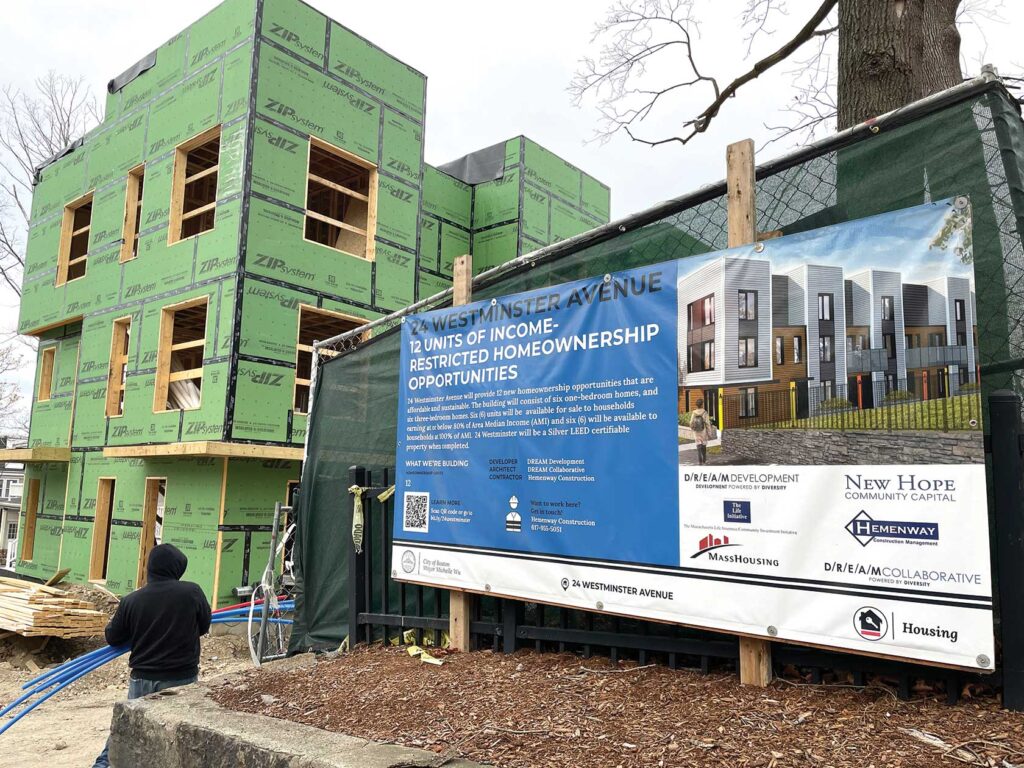
Next summer, when work on 24 Westminster Ave. is finished, the 12 units currently under construction will go on the market with an average sale price below $600,000. The units are compact, thoughtfully designed and, according to Dream Development Managing Director Gregory Minott, demonstrate the possibility for building affordable housing without subsidies.
“We got close on this project,” Minott said, noting that Dream Development tapped the quasi-governmental Massachusetts Housing Investment Corporation for funding to make the units affordable to buyers.
Half the units in the building will be available to buyers earning up to 80% of the area median income ($91,440 for an individual) and half will be available to buyers earning up to 100% of the area median income ($114,300 for an individual).
Each unit has a private entryway, a deck and its own outdoor space. Nine parking spaces are included onsite.
“There’s big windows and lots of natural light,” Minott said. “There’s a shared lawn in the back.”
Dream development was also able to keep many of the trees on the lot, which has been vacant for decades.
Affordable without subsidy
Developers like Minott have told city officials they are willing to build low-cost housing, but many say that the costs associated with land acquisition, permitting and the community review processes necessary to obtain zoning variances push costs up, according to Paige Roosa, director of the Mayor’s Housing Innovation Lab.
“The hypothesis is we could incentivize developers to do this if we could de-risk the development process,” she said.
In 2011, city officials began looking at micro units — one-bedroom and studio apartments that come in at around 350 square feet — as a way to produce affordable units. The first such units opened in 2013 in the Seaport District, but rents in the downtown neighborhoods where they appeared were well above $2,000 a unit — not exactly affordable.
In 2016, the Housing Lab pushed developers to present different models for compact, low-cost homes that could be built in Boston’s traditionally more affordable neighborhoods. City officials produced a 360-square foot demonstration unit mounted on a trailer that was on display at sites throughout the city.
Dream Development obtained the 10,000 square foot parcel at 24 Westminster Ave. in 2018 from the city for the rock-bottom price of $150,000 as part of the city’s Compact Living Pilot. Apart from the steep discount on the land, the city provided the 17 developers awarded parcels with no additional subsidies.
So far, eight of the 12 projects that obtained permits through the Compact Living Pilot have been completed.
Minott said the pandemic and the resulting increased costs and scarcity of building materials delayed the project and forced Dream Development to seek and obtain funding from the Massachusetts Housing Investment Corporation.
“We faced price increases several times,” he said. “We had to reduce costs in some areas to make it work. We made a few changes in the materials we are using, but nothing that would affect the quality.”
The project consists of a single elongated structure housing 12 units — six one-bedroom condos and six three-bedroom condos. The small size of the units — the three-bedroom units are just under 1,000 square feet — meant Dream Development had to obtain variances from the Zoning Board of Appeal, adding more delays to the project.
Minott said Dream Development will look to produce similar development projects in Boston’s neighborhoods. While the Westminster Street project was 100% affordable, he estimates he could produce similar condo buildings with one-third of the units at market rate and the rest moderately affordable, with units in the $530,000 range.
But he says the city’s current zoning codes, which mandate larger unit sizes, remain an obstacle.
“What we did is not possible under the current zoning code,” he said. “The small unit size is the thing we can control to keep the costs down.”
Accessory dwelling units
Other initiatives the Housing Innovation Lab is pursuing include accessory dwelling units (ADUs) — compact housing units built as additions to a home or as detached units on a homeowner’s property.
Last month the city announced new assistance for homeowners wishing to build ADUs on their property including bank loans tailored to the construction of such units, a technical assistance grant of up to $7,500 to assist with pre-construction costs and an ADU Guidebook outlining the process for constructing such units.
“It’s not really easy for home owners to assemble the funds for ADUs,” Roosa said. “Home owners are having to act as developers for the first time.”
As part of the Boston Planning and Development Agency’s PLAN Mattapan re-zoning process, home owners in that neighborhood can build detached ADUs as-of-right, meaning they do not have to obtain a variance from the Zoning Board of Appeal.
Roosa said the Housing Innovation Lab is looking into ways to make off-site construction available to Boston developers and home owners. In off-site construction, a firm assembles components of a housing unit such as bathrooms, kitchens, interior and exterior walls and roofs which can then be rapidly assembled on a building site. Off-site construction could be used for ADUs or larger housing units.
“We’ve been working on what Boston’s next starter home could look like,” Roosa said.
The need for more affordable new construction in pressing. Boston area residents between the ages of 25 and 44 — those most likely to be first-time home buyers — have a median income of $125,000. While that income level would enable buyers to afford a home at between $500,000 and $600,000, just one-in-five newly constructed homes in Boston come in at that price point, Roosa said.







